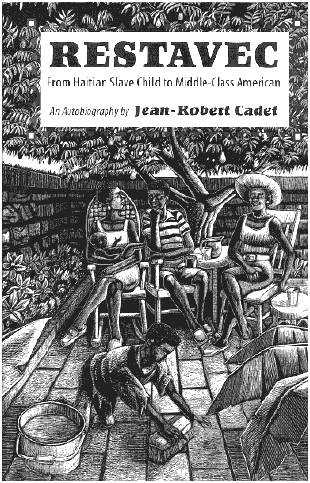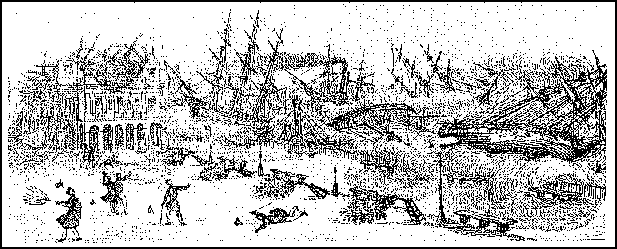From Haitian Slave Child
To Middle-Class American
Jean-Robert Cadet
(Texas)

Restavecs are slave children who belong to well-to-do families. They receive no pay and are kept out of school...Restavecs are treated worse than slaves, because they don't cost anything and their supply seems inexhaustible. They do the jobs that the hired domestics, or bonnes, will not do and are made to sleep on cardboard, either under the kitchen table or outside on the front porch. For any minor infraction they are severely whipped with the cowhide that is still being made exclusively for that very purpose.
Florence turns out to be somewhat sadistic. One of Cadet's first (and worst) jobs is to scrub the rags that she uses for her period. Since he didn't know where the blood is coming from, he's convinced she's going to die. As brutal as she is, the thought of her death fills him with fear, because he knows that then he will be sent out to the streets.
None of the details of being a child slave are left out: the beatings, the long hours, the active attempt to keep Cadet from school...and his bed-wetting. When he asks permission to attend Confession and Communion, Florence says,
You little shithead bedwetter, you little faggot, you shoeshine boy. If you think I'm gonna spend my money on your First Communion, you're insane.
Well it's a dismal tale, and it does go on. The change comes when the family emigrates to New York, and Philippe comes up with the money for Cadet to accompany them. His first day at school,
I looked in every corner of the room, searching for a whip. There was none..."Oh my God, everyone is so smart that the teacher does not need a whip. Maybe when he realizes that everyone is smarter than I am, he will bring a whip just for me."
Florence, it turns out, has been transformed, feeding him the same food that she gives to her other children. There are other differences as well: "I soon learned that in this country chickens were sold dead --- without feet, heads, or feathers."
Cadet's tale is not uninteresting: the life of near-slavery, the liberating experience that comes with America, his military service, becoming a teacher in the Middle West. However, Restavec suffers from two profound flaws. One is that the recounting of unrelieved misery can make the reader miserable as well --- witness the overwrought child-terror in The Painted Bird. Even a brutalized slave-child can find some magic in life, especially in Haiti. A butterfly comes into Florence's house, "a bad spirit send by the enemy" to "tie" her unborn baby.
I became paranoid, thinking that a loup-garou would kill me or suck my blood on my way to the ravine.
The voodoo that is Haiti has magic and color, but we find little of this in Restavec.
On top of this, once he reaches majority in America, Cadet's life is tainted by an heavy puritan streak. When he finds his bunk mates smoking dope, he feels compelled to go to the army's Criminal Investigation Division:
"What can I do for you?" he asked.
"I want something done about a serious drug problem in the barracks," I said.
"Have you told this to your commanding officer?" asked the warrant officer.
"No, I don't want to go through the chain of command because the platoon sergeant is one of the distributors," I said.
This is not necessarily the kind of guy we would want to spend our time with if we got drafted, for outside of being a rat-fink, he doesn't drink, and with his insufferable gung-ho, puts everyone else to shame.
One of his mates invites him to visit with his Norman Rockwell family, but Cadet finds it impossible to speak with them, hides outside most of the time, contemplates suicide, and wets his bed yet again. (Like most bedwetters, he devises elaborate schemes to hide the urine-soaked sheets.)
He goes to work for a large corporation, but is convinced that others are being paid more than he is, and to confirm it, waits until his fellow worker goes off:
As soon as he went to men's room, I searched his pocket to verify his salary. It was four times my amount.
Cadet's life was miserable, but he is not without wit and resources. The pity is that he has painted such a derogatory portrait of himself that by the time we get to the end of his story, we find ourselves feeling rather relieved that he doesn't live down the street from us or, worse, work in the same office that we do.
Apprentice
Tahir Shah
(Arcade)
Feroze --- now into his seventies --- is not interested in taking on a student, but Shah begs, Feroze ponders --- then assigns him some excruciating exercises to prove his fealty, like crawling around on the ground for a day or so, turning his elbows and knees to hamburger while he looks for bits of shell hidden in the volcanic dirt.
Several weeks of similar exercises leads to further mayhem --- being forced to swallow huge pebbles, ingesting acidic soap, then standing blindfolded atop two chairs while he recites such lore as the history of Houdini's life, Boyle's Law, or entire passages from the Mahabarata.
It's moderately interesting, except for the fact that Feroze comes across as a prissy old sadist, and Shah as a whiner. In addition, the style of writing leaves much to be desired: the plotting is predictable, the dialogue is hokey, and it comes across as one of those late-nineteenth century adventure tales out of the penny-dreadfuls, filled with castanets and eyes "shimmering like fire-opals:"
"How am I to address you, Mr. Feroze?"
The magician ran a fingertip across the top edge of a picture frame, checking for dust.
"People like to call me 'Master,'" he replied.
"When am I to begin lessons?"
Feroze snipped the calipers like castanets. Then, scowling across at me, his green eyes shimmering like fire-opals, he shouted:
"Immediately...We start immediately!"
On the other hand, the descriptions of street life in Calcutta are a treat.
Total number of pages read: 147
Change
Hurricanes and the
Transformation of
19th Century Cuba
Louis A. Pérez, Jr.
(Chapel Hill)

If you are looking for hurricanes, Cuba is the place to go. According to Pérez' calculations, between the coming of the Spanish and their departure four centuries later, over 400 of these tempests swept the island. And there were three that came in the mid-1840s to profoundly change the economy, the society, and the political world of country.For almost fifty years (1791 - 1842) there had been no major storms. Then, in the mid-40s, three swept the from the south, passed in and around Havana, and destroyed life and property --- and a distinctive way of life --- with particular force. The descriptions of them are as spectacular as the hurricanes themselves:
So vivid and incessant is the lightening that the whole heavens seem in conflagration; appalling thunders mingle their stormy music with the roar of the waves, the shriek of the winds, and the frantic cries of those [who] are in expectation of almost immediate death...there is little hope of safety in flight, for there is danger being blown over a precipice, or struck by the boards and shingles, which are drifted to and fro as if they were light as threads of gossamers.
Another wrote,
I know of no other instance of inhabitants drowning in their own homes as a result of water driven by the wind through the doors, windows, and the roofs, whose tiles flew about like feathers. Many fled into the streets, envisioning their imminent death by being buried alive in the ruins of their homes or drowning by the raging waves of the sea that invaded the town...
Such storms were unheard of in Europe --- and early in the reign of the Spanish, some said that they came to punish the colonials for their mistreatment of the Indians. The Spanish tried to predict the date of the upcoming storms, and Columbus, looney as always, reported that they would be preceded by the appearance of a repulsive sea monster, big as a medium-sized whale with a carapace like a turtle's, a horrible head like a barrel, and two wings.
§ § § Before 1844, Cuba was as prosperous as any of the colonies --- with grant and rich coffee plantations. Slaves, known as cafetales, numbering some 500,000, tended the plants and harvested the crops and, according to reports, were treated, largely, benignly. However, with these powerful storms, most of the coffee-growing plantations were destroyed. Sugar-cane took the place of coffee.
Because of the intense heat and delicate timing needed to draw sugar from the cane, the mortality rate amongst the workers was appallingly high. One contemporary said that
while the sugar-making slave, beginning his labours at sixteen or eighteen years of age, has certainly on an average not more than ten years to live, the coffee-picking slave may fairly reckon on twenty-five or thirty years, without ever having endured the same severity of toil or same intensity of suffering.
Another observer said that, in the production of sugar,
every slave was worked under the whip 18 hours out of the 24, and, in the boiling houses, from 5 AM to 6 PM, and from 11 AM to midnight, when half the people were concluding their 18 hours work; the sound of the hellish lash was incessant; indeed, was necessary to keep the overtasked wretched awake.
The annual death rate was somewhere between 10 - 18%.
§ § § There are myriad of interesting facts that Pérez comes up with. Hurricanes then as now, were given names --- the two largest of that decade were called "San Francisco de Asis" and "San Francisco de Borja." The architecture of the Spanish colonials --- straight streets, building in the lowlands, much tile work --- invited disaster from the storms. Because the English were actively interfering with the slave trade, sugar growers in mid-nineteenth Century Cuba began to angle for the America to take over their country: at that time, unlike most other parts of the industrialized world --- slavery was alive and well in the southern United States.
Pérez even believes that tempests that occurred later in the century contributed to the uprising that ended Spanish rule. Nationalism was engendered in a people who --- every year, from August to October --- were fearful of the great storms; when the hurricanes arrived, all gathered together for mutual self-protection. These disasters thus helped Cubans to define themselves as a nation.
These storms entered into the language of the people and their poetry as symbols. One writer of the 1960s even spoke of "Huracán Fidel" who
planted death and desolation in the mountains, plains, valleys and cities of Cuba...Thousands fled in fear by sea and air and thousands of others, less fortunate, perished attempting to escape the uncontrollable fury of the fearful hurricane Fidel.
---Carlos Amantea